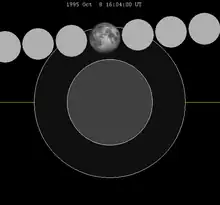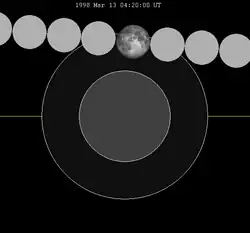| Total Lunar Eclipse September 27, 1996 | |
|---|---|
 The Moon passes west to east (right to left) across the Earth's umbral shadow, shown in hourly intervals. | |
| Series | 127 (41 of 72) |
| Duration (hr:mn:sc) | |
| Totality | 1:09:12 |
| Partial | 3:23:17 |
| Penumbral | 5:20:52 |
| Contacts | |
| P1 | 0:13:59 UTC |
| U1 | 1:12:43 |
| U2 | 2:19:46 |
| Greatest | 2:54:22 |
| U3 | 3:28:57 |
| U4 | 4:35:59 |
| P4 | 5:34:51 |
A total lunar eclipse took place on Friday, September 27, 1996, the second of two lunar eclipses in 1996, the first being on Thursday, April 4. This is the 41st member of Lunar Saros 127. The previous event is the September 1978 lunar eclipse. The next event is the October 2014 lunar eclipse.
This eclipse was the second of an almost tetrad (that occurred when there were 4 consecutive lunar eclipses that had an umbral eclipse magnitude of 0.9 or greater). The others were 04 Apr 1996 (T), 24 Mar 1997 (P) and 16 Sep 1997 (T).
Visibility
It was visible from all of North and South America, Europe and Africa.

Mid-infrared image of the Moon

During its totality, the Midcourse Space Experiment (MSX) satellite's SPIRIT-III instrument took the image of the Moon in mid-infrared. At these wavelengths, MSX was able to characterize the thermal (heat) distribution of the lunar surface during the eclipse. The brightest regions are the warmest, and the darkest areas are the coolest. The well-known crater Tycho is the bright object to the south of center. Numerous other craters are also seen as bright spots, indicating that their temperature is higher than in the surrounding dark mare.[1]
Related eclipses
Eclipses of 1996
- A total lunar eclipse on April 4.
- A partial solar eclipse on April 17.
- A total lunar eclipse on September 27.
- A partial solar eclipse on October 12.
Lunar year series
This is the second of four lunar year eclipses at the descending node of the Moon's orbit.
| Lunar eclipse series sets from 1995–1998 | ||||||||
|---|---|---|---|---|---|---|---|---|
| Ascending node | Descending node | |||||||
| Saros Photo |
Date Viewing |
Type Chart |
Gamma | Saros Photo |
Date Viewing |
Type Chart |
Gamma | |
| 112 | 1995 Apr 15 |
Partial |
−0.95939 | 117 | 1995 Oct 08 |
Penumbral |
1.11794 | |
122 |
1996 Apr 04 |
Total |
−0.25339 | 127 |
1996 Sep 27 |
Total |
0.34264 | |
132 |
1997 Mar 24 |
Partial |
0.48990 | 137 | 1997 Sep 16 |
Total |
−0.37684 | |
| 142 | 1998 Mar 13 |
Penumbral |
1.19644 | 147 | 1998 Sep 06 |
Penumbral |
−1.10579 | |
| Last set | 1994 May 25 | Last set | 1994 Nov 18 | |||||
| Next set | 1999 Jan 31 | Next set | 1998 Aug 08 | |||||
Saros series
Lunar saros series 127, repeating every 18 years and 11 days, has a total of 72 lunar eclipse events including 54 umbral lunar eclipses (38 partial lunar eclipses and 16 total lunar eclipses). Solar Saros 134 interleaves with this lunar saros with an event occurring every 9 years 5 days alternating between each saros series.
| Greatest | First | |||
|---|---|---|---|---|
The greatest eclipse of the series occurred on 1888 Jul 23, lasting 102 minutes. |
Penumbral | Partial | Total | Central |
| 1275 Jul 09 | 1473 Nov 04 | 1798 May 29 | 1834 Jun 21 | |
| Last | ||||
| Central | Total | Partial | Penumbral | |
| 1960 Sep 05 | 2068 Nov 09 | 2429 Jun 17 | 2555 Sep 02 | |
| 1906 Aug 04 | 1924 Aug 14 | 1942 Aug 26 | |||
 |
 |
 |
 |
 |
 |
| 1960 Sep 05 | 1978 Sep 16 | 1996 Sep 27 | |||
 |
 |
 |
 |
 |
 |
| 2014 Oct 08 | 2032 Oct 18 | 2050 Oct 30 | |||
 |
 |
 |
 |
 |
 |
| 2068 Nov 09 | |||||
 |
 | ||||
Half-Saros cycle
A lunar eclipse will be preceded and followed by solar eclipses by 9 years and 5.5 days (a half saros).[2] This lunar eclipse is related to two annular solar eclipses of Solar Saros 134.
| September 23, 1987 | October 3, 2005 |
|---|---|
 |
 |
See also
References
- ↑ NASA Astronomy Picture of the Day: Eclipsed Moon in Infrared (8 November 2003)
- ↑ Mathematical Astronomy Morsels, Jean Meeus, p.110, Chapter 18, The half-saros
External links
- Saros cycle 127
- 1996 Sep 27 chart Eclipse Predictions by Fred Espenak, NASA/GSFC
- September 1996 lunar eclipse

_(cropped).jpg.webp)
